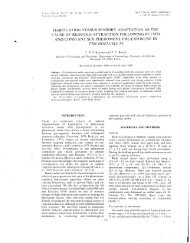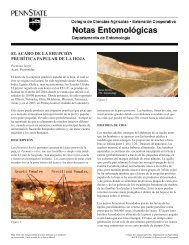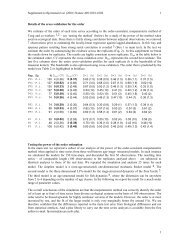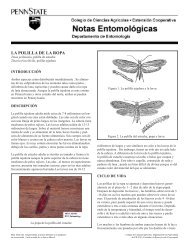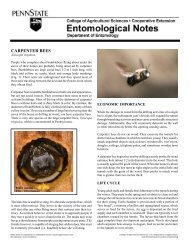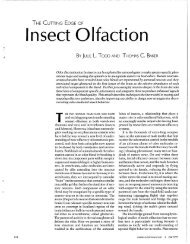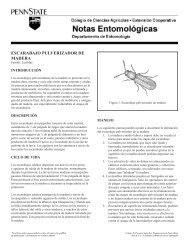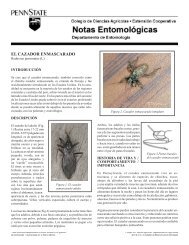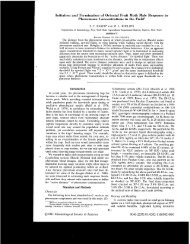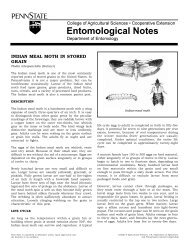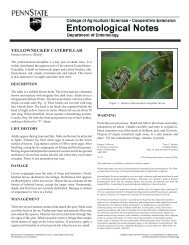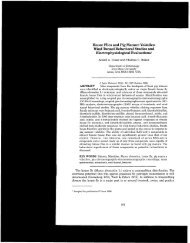Learning the Language of Insects- and How to Talk Back - Entomology
Learning the Language of Insects- and How to Talk Back - Entomology
Learning the Language of Insects- and How to Talk Back - Entomology
You also want an ePaper? Increase the reach of your titles
YUMPU automatically turns print PDFs into web optimized ePapers that Google loves.
communication, amplitude modulation involves"chirping" or "trilling" with long orshort periods <strong>of</strong> silence, ra<strong>the</strong>r than emittinga continuous <strong>to</strong>ne (Fig. 2D) Inchemical communication, amplitude modulationusually is provided by <strong>the</strong> turbulentshearing <strong>of</strong> <strong>the</strong> emission as it leaves <strong>the</strong>source <strong>to</strong> create filaments <strong>of</strong> odor similar <strong>to</strong>what we can visualize within smoke plumes(Fig 2F). <strong>How</strong>ever, some rhythmic pulsing<strong>of</strong> chemical emissions can be imparted by<strong>the</strong> emitter, such as arctiid or lymantriidmoths emitting pheromone, <strong>and</strong> <strong>the</strong>se can,in some cases, st<strong>and</strong> out against <strong>the</strong> turbulence-inducedmodulation for a half a meteror so downwind (Conner et a1 1980) Suchpulsing thus far has been found <strong>to</strong> have noextra signal value <strong>and</strong> also does not increase<strong>the</strong> response <strong>of</strong> males compared <strong>to</strong> a continuouslyemitted stream <strong>of</strong> pheromone.No signal from insects has yet beenfound that is frequency modulated <strong>and</strong> hascommunication value Frequency modulated(FM) signals would involve changingcolor, sweeping through a series <strong>of</strong> <strong>to</strong>nes, orchanging one's chemical blend <strong>How</strong>ever,bats hunting for insect prey are FM emittersthat with each ultrasonic chirp sweepdownward from high <strong>to</strong> low <strong>to</strong>nes <strong>and</strong> from<strong>the</strong> particular narrow range <strong>of</strong> <strong>to</strong>nes <strong>of</strong> <strong>the</strong>reflected signal, ga<strong>the</strong>r information about<strong>the</strong> size <strong>and</strong> wing-beat frequency <strong>of</strong> <strong>the</strong>irprey These bats also modulate <strong>the</strong> amplitude<strong>of</strong> <strong>the</strong>ir cries by sending discrete chirpswith a silent period that aids in receivingechoes, but <strong>the</strong>re are species that emit AM(amplitude modulated) cries only, with n<strong>of</strong>requency sweeps The moths that arehunted have not been shown <strong>to</strong> beresponsive <strong>to</strong> <strong>the</strong> FM modulations <strong>of</strong> <strong>the</strong>cries, but ra<strong>the</strong>r react defensively by trying<strong>to</strong> evade <strong>the</strong> bats in response <strong>to</strong> a wide range<strong>of</strong> ultrasonic <strong>to</strong>nes across <strong>the</strong> frequencyrange <strong>of</strong> <strong>the</strong> sweepsBat-moth communication brings up <strong>the</strong>aspect <strong>of</strong> reflected versus emitted signals in<strong>the</strong> three modalities Bats are providing<strong>the</strong>ir own sonic lanterns, 01 strobe lights, ifyou will, with which <strong>the</strong>y peer in<strong>to</strong> <strong>the</strong>darkness for moving prey items They relyon reflected sound for information <strong>to</strong> flow<strong>to</strong> <strong>the</strong>m about prey. Most visually dependentinsect preda<strong>to</strong>rs <strong>and</strong> parasi<strong>to</strong>ids relyon ambient light from <strong>the</strong> sun <strong>to</strong> reflect <strong>of</strong>fprey items <strong>and</strong> provide information flow.Likewise, most visual communication systemsuse reflected, ambient light, except in<strong>the</strong> notable cases <strong>of</strong> firefly communication,in which emitted signals are <strong>the</strong> rule.Emitted, ra<strong>the</strong>r than reflected, sounds are<strong>the</strong> rule for insects that communicate bymeans <strong>of</strong> pressure disturbances. <strong>How</strong>ever,some species do enhance <strong>the</strong>n resonance byreflecting <strong>the</strong>n emissions <strong>of</strong>f <strong>of</strong> <strong>the</strong> sides <strong>of</strong>Winter 1 99 3Fig. 1,. Diagram <strong>of</strong> information flow that results in communication. The signal is depicted asfluctuating in amplitude (wavy purple line), whereas noise in <strong>the</strong> communication channel is depictedas being unvarying in amplitude (straight lines), but <strong>of</strong> a different carrier frequency (yellow instead <strong>of</strong>purple). The signal is able <strong>to</strong> be received <strong>and</strong> responded <strong>to</strong> even with <strong>the</strong> background noise presentdue <strong>to</strong> <strong>the</strong> different carrier frequency <strong>and</strong> its amplitude modulation relative <strong>to</strong> <strong>the</strong> noise (afterShannon 6- Weaver 1949)specially constructed burrows, or <strong>of</strong>f <strong>of</strong>leaves enlisted <strong>to</strong> increase <strong>the</strong> resonance <strong>of</strong><strong>the</strong>ir emissions for <strong>the</strong> same purpose(Prozesky-Schulze et a1 1975)Semiochemical communication in insectsinvolves both emitted <strong>and</strong> reflectedcompounds. Obviously "you are what youeat" means that all a<strong>to</strong>ms emitted fromwithin one's body must have at some pointbeen assimilated from an external source,<strong>and</strong>, <strong>the</strong>refore, could be considered "reflected."<strong>How</strong>ever, some molecules areingested or adsor bed from surroundings<strong>and</strong> <strong>the</strong>n reemitted as a signal in more-orlessunaltered form, as shown by TomEisner in his work on <strong>the</strong> defensive compounds<strong>of</strong> many insects (see, for example,Eisner 1970 for review) The results <strong>of</strong>many studies on courtship pheromonesemitted by male moths have shown that<strong>the</strong>se pheromones also are comprised <strong>of</strong>mainly plant-derived, little-altered molecules.O<strong>the</strong>r semiochemicals are mainlyself-generated, syn<strong>the</strong>sized emissions, asexemplified by <strong>the</strong> lepidopteran sex pheromonesmanufactured from building-blockacetate molecules, as highlighted by <strong>the</strong>work <strong>of</strong> Lou Bjostad <strong>and</strong> Wendell Roel<strong>of</strong>s(see Bjostad & Roel<strong>of</strong>s 1987 for review)O<strong>the</strong>r common properties <strong>of</strong> communicationin any <strong>of</strong> <strong>the</strong>se modalities include <strong>the</strong>fact that sustained reception <strong>of</strong> intact signalsis affected both by background noise in<strong>the</strong> channel <strong>and</strong> by adaptation <strong>of</strong> <strong>the</strong> sensorypathways, whe<strong>the</strong>r <strong>the</strong> system involveslight, sound, 01 chemicals If some <strong>of</strong><strong>the</strong> sensory pathways in <strong>the</strong> receiver havebeen made dysfunctional from adaptationdue <strong>to</strong> background noise, <strong>the</strong>n <strong>the</strong> signalthat reaches <strong>the</strong> brain may have beenseverely altered <strong>and</strong> rendered ineffective inevoking behaviorAno<strong>the</strong>r major commonality amongcommunication systems in <strong>the</strong> three mainmodalities is <strong>the</strong> way in which communicationsystems are dissected by researchersin older <strong>to</strong> distill <strong>the</strong> minimal set <strong>of</strong> signalsimportant in evoking a response in receiversFirst, <strong>the</strong> natural sequence <strong>of</strong> behaviorsneeds <strong>to</strong> be observed <strong>and</strong> analyzed for <strong>the</strong>researcher <strong>to</strong> get a feeling as <strong>to</strong> which parts<strong>of</strong> <strong>the</strong> sender-r eceiver inter action appear <strong>to</strong>be important in evoking a response, or ino<strong>the</strong>r words, in successfully communicating,as indicated by <strong>the</strong> response. Then <strong>the</strong>naturally emitted signal needs <strong>to</strong> be captured<strong>and</strong> played back for detailed analysisIn visual communication, relative reflectances<strong>of</strong> insect body par ts such as wings canbe gained by obtaining <strong>the</strong>m <strong>and</strong> placing<strong>the</strong>m in spectropho<strong>to</strong>meters <strong>to</strong> determine<strong>the</strong> major hues 01 carrier frequencies thatare preferentially reflected <strong>and</strong> absorbed bypigments struck by ambient, white sunlightThe emission spectrum <strong>of</strong> fireflies canbe immediately captured <strong>and</strong> measured ona spectropho<strong>to</strong>meter <strong>and</strong> displayed <strong>to</strong> find<strong>the</strong> major peak emission frequency orwavelength <strong>of</strong> light Temporal analysis <strong>of</strong><strong>the</strong> tempos at which wing reflectances areamplitude modulated 01 firefly flashes arepulsed, as well as <strong>the</strong> durations <strong>of</strong> <strong>the</strong>flashes <strong>and</strong> pulses can be recor ded on film orvideotape <strong>and</strong> measured during playback.



